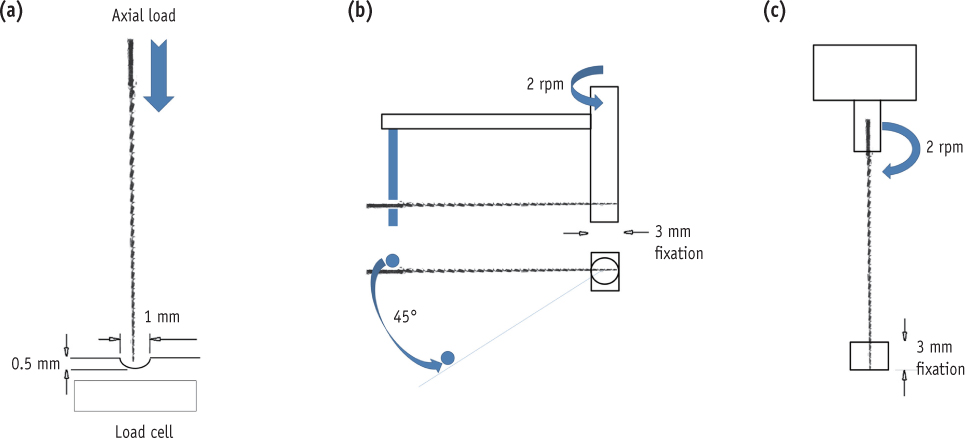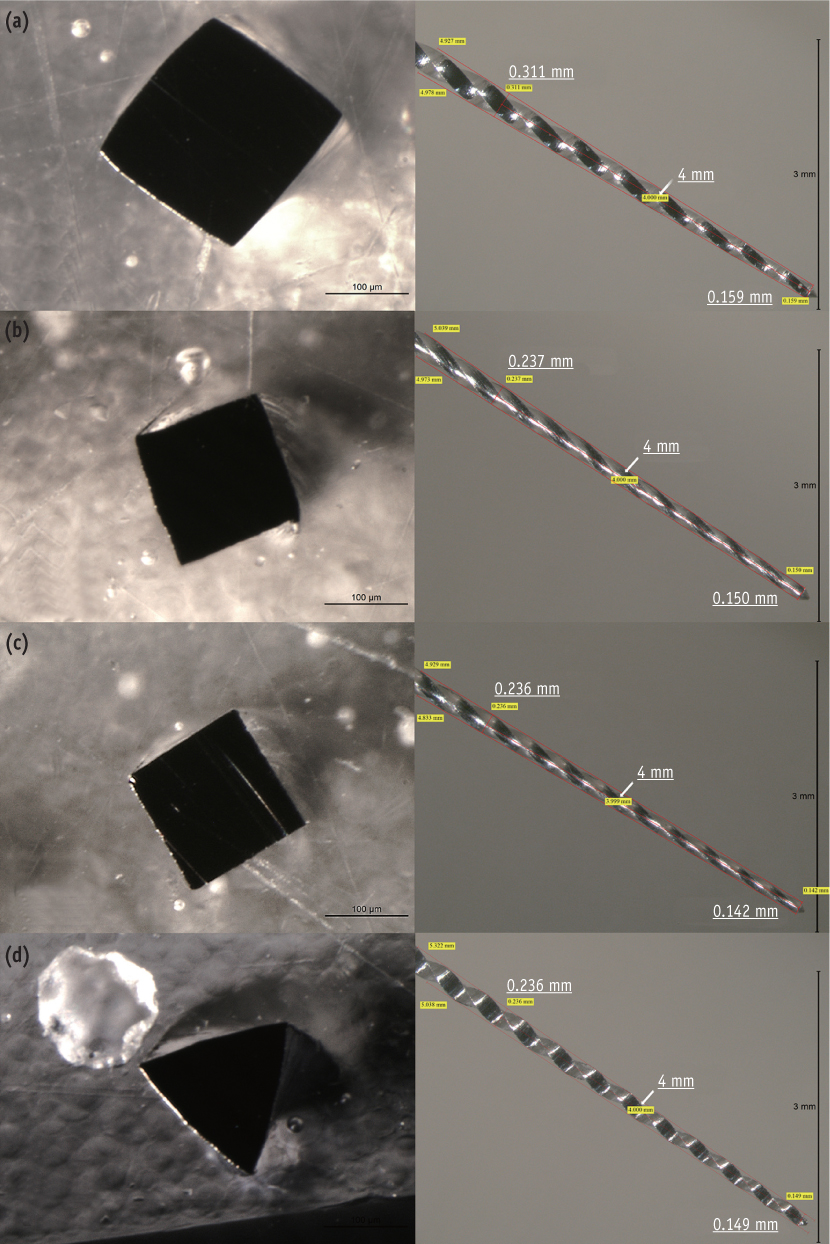Restor Dent Endod.
2014 Nov;39(4):270-275. 10.5395/rde.2014.39.4.270.
Buckling resistance, bending stiffness, and torsional resistance of various instruments for canal exploration and glide path preparation
- Affiliations
-
- 1Department of Conservative Dentistry, School of Dentistry and Dental Research Institute, Pusan National University, Yangsan, Korea. golddent@pusan.ac.kr
- 2Department of Conservative Dentistry, School of Dentistry, Kyungpook National University, Daegu, Korea.
- 3Department of Conservative Dentistry, School of Dentistry and Dental Research Institute, Seoul National University, Seoul, Korea.
- KMID: 2316907
- DOI: http://doi.org/10.5395/rde.2014.39.4.270
Abstract
OBJECTIVES
This study compared the mechanical properties of various instruments for canal exploration and glide-path preparations.
MATERIALS AND METHODS
The buckling resistance, bending stiffness, ultimate torsional strength, and fracture angle under torsional load were compared for C+ file (CP, Dentsply Maillefer), M access K-file (MA, Dentsply Maillefer), Mani K-file (MN, Mani), and NiTiFlex K-file (NT, Dentsply Maillefer). The files of ISO size #15 and a shaft length of 25 mm were selected. For measuring buckling resistance (n = 10), the files were loaded in the axial direction of the shaft, and the maximum load was measured during the files' deflection. The files (n = 10) were fixed at 3-mm from the tip and then bent 45degrees with respect to their long axis, while the bending force was recorded by a load cell. For measuring the torsional properties, the files (n = 10) were also fixed at 3-mm, and clockwise rotations (2-rpm) were applied to the files in a straight state. The torsional load and the distortion angle were recorded until the files succumbed to the torque.
RESULTS
The CP was shown to require the highest load to buckle and bend the files, and the NT showed the least. While MA and MN showed similar buckling resistances, MN showed higher bending stiffness than MA. The NT had the lowest bending stiffness and ultimate torsional strength (p < 0.05).
CONCLUSIONS
The tested instruments showed different mechanical properties depending on the evaluated parameters. CP and NT files were revealed to be the stiffest and the most flexible instruments, respectively.
Keyword
MeSH Terms
Figure
Reference
-
1. Siqueira JF Jr. Aetiology of root canal treatment failure: why well-treated teeth can fail. Int Endod J. 2001; 34:1–10.
Article2. Haapasalo M, Endal U, Zandi H, Coil JM. Eradication of endodontic infection by instrumentation and irrigation solutions. Endod Topics. 2005; 10:77–102.
Article3. Cheung GS, Liu CS. A retrospective study of endodontic treatment outcome between nickel-titanium rotary and stainless steel hand filing techniques. J Endod. 2009; 35:938–943.
Article4. Sonntag D, Guntermann A, Kim SK, Stachniss V. Root canal shaping with manual stainless steel files and rotary Ni-Ti files performed by students. Int Endod J. 2003; 36:246–255.
Article5. Ha JH, Park SS. Influence of glide path on the screw-in effect and torque of nickel-titanium rotary files in simulated resin root canals. Restor Dent Endod. 2012; 37:215–219.
Article6. Berutti E, Negro AR, Lendini M, Pasqualini D. Influence of manual preflaring and torque on the failure rate of ProTaper rotary instruments. J Endod. 2004; 30:228–230.
Article7. Patiño PV, Biedma BM, Liébana CR, Cantatore G, Bahillo JG. The influence of a manual glide path on the separation rate of NiTi rotary instruments. J Endod. 2005; 31:114–116.
Article8. Siqueira JF Jr, Lopes HP. Chemomechanical preparation. In : Siqueira JF, editor. Treatment of endodontic infections. London: Quintessence Publishing;2011. p. 236–284.9. Allen MJ, Glickman GN, Griggs JA. Comparative analysis of endodontic pathfinders. J Endod. 2007; 33:723–726.
Article10. Lopes HP, Elias CN, Amaral G, Vieira VT, Moreira EJ, Mangelli M, Siqueira JF Jr. Torsional properties of pathfinding instruments. Oral Surg Oral Med Oral Pathol Oral Radiol Endod. 2011; 112:667–670.
Article11. Beer FP, Johnston ER, DeWolf JT, Mazurek DF. Mechanics of materials. 6th ed. New York: Mc Graw-Hill;2012. p. 631–391.12. Lopes HP, Elias CN, Mangelli M, Lopes WS, Amaral G, Souza LC, Siqueira JF Jr. Buckling resistance of pathfinding endodontic instruments. J Endod. 2012; 38:402–404.
Article13. Jafarzadeh H, Abbott PV. Ledge formation: review of a great challenge in endodontics. J Endod. 2007; 33:1155–1162.
Article14. Berutti E, Cantatore G, Castellucci A, Chiandussi G, Pera F, Migliaretti G, Pasqualini D. Use of nickel-titanium rotary PathFile to create the glide path: comparison with manual preflaring in simulated root canals. J Endod. 2009; 35:408–412.
Article15. Nakagawa RK, Alves JL, Buono VT, Bahia MG. Flexibility and torsional behaviour of rotary nickel-titanium PathFile, RaCe ISO 10, Scout RaCe and stainless steel K-File hand instruments. Int Endod J. 2014; 47:290–297.
Article16. Kim TO, Cheung GS, Lee JM, Kim BM, Hur B, Kim HC. Stress distribution of three NiTi rotary files under bending and torsional conditions using a mathematic analysis. Int Endod J. 2009; 42:14–21.
Article17. Cheung GS, Shen Y, Darvell BW. Effect of environment on low-cycle fatigue of a nickel-titanium instrument. J Endod. 2007; 33:1433–1437.
Article18. Kramkowski TR, Bahcall J. An in vitro comparison of torsional stress and cyclic fatigue resistance of ProFile GT and ProFile GT Series X rotary nickel-titanium files. J Endod. 2009; 35:404–407.
Article19. Yum J, Cheung GS, Park JK, Hur B, Kim HC. Torsional strength and toughness of nickel-titanium rotary files. J Endod. 2011; 37:382–386.
Article20. Cho OI, Versluis A, Cheung GS, Ha JH, Hur B, Kim HC. Cyclic fatigue resistance tests of Nickel-Titanium rotary files using simulated canal and weight loading conditions. Restor Dent Endod. 2013; 38:31–35.
Article21. ISO-Standards ISO 3630-1 Dental root canal instruments. Part 1: files, reamers, barbed broaches, rasps, paste carriers, explorers and cotton broaches. Switzerland: International Organization for Standardization;1992.22. Council on Dental Materials, Instruments and Equipment. Revised American National Standards Institute/ American Dental Association Specification no. 28 for root canal files and reamers, type K. J Am Dent Assoc. 1982; 104:506.23. Gutmann JL, Lovdahl PE. Problem Solving in Endodontics. Prevention, Identification, and Management. 5th ed. Maryland Heights, MO: Elsevier/Mosby;2011. p. 195–208.24. West JD. The endodontic glidepath: 'secrets to rotary satety'. Dent Today. 2010; 29:868890–93.25. Blum JY, Machtou P, Ruddle C, Micallef JP. Analysis of mechanical preparations in extracted teeth using ProTaper rotary instruments: value of the safety quotient. J Endod. 2003; 29:567–575.
Article26. Lee MH, Versluis A, Kim BM, Lee CJ, Hur B, Kim HC. Correlation between experimental cyclic fatigue resistance and numerical stress analysis for nickel-titanium rotary files. J Endod. 2011; 37:1152–1157.
Article
- Full Text Links
- Actions
-
Cited
- CITED
-
- Close
- Share
- Similar articles
-
- Comparative analysis of torsional and cyclic fatigue resistance of ProGlider, WaveOne Gold Glider, and TruNatomy Glider in simulated curved canal
- Canal preparation with nickel-titanium or stainless steel instruments without the risk of instrument fracture: preliminary observations
- Comparison of the ability of Reciproc and Reciproc Blue instruments to reach the full working length with or without glide path preparation
- Influence of glide path size and operating kinetics on time to reach working length and fracture resistance of Twisted File adaptive and Endostar E3 nickel-titanium file systems
- Influence of glide path on the screw-in effect and torque of nickel-titanium rotary files in simulated resin root canals



